Building a DIY hydrogen fuel cell can transform your home into a clean energy powerhouse. You'll need to understand the basics of fuel cells, prioritize safety with proper ventilation and hydrogen detectors, and gather essential materials like proton exchange membranes and catalysts. Designing your system involves determining power requirements and choosing between compressed hydrogen or on-demand electrolysis. You'll assemble the fuel cell stack, integrate it with your home's electrical system, and set up storage methods. Regular maintenance and troubleshooting are vital for peak performance. With the right knowledge and precautions, you can harness this innovative technology for sustainable home power.
Understanding Hydrogen Fuel Cells

A hydrogen fuel cell is an electrochemical device that converts hydrogen and oxygen into electricity, with water as its only byproduct. It's a clean and efficient way to generate power, making it an attractive option for sustainable energy production.
You'll find that fuel cells consist of three main components: an anode, a cathode, and an electrolyte membrane.
The process begins when hydrogen enters the anode side of the fuel cell. Here, a catalyst splits the hydrogen molecules into protons and electrons. The protons pass through the electrolyte membrane, while the electrons are forced to travel through an external circuit, creating an electric current.
Meanwhile, oxygen enters the cathode side and combines with the protons and electrons, forming water.
You'll appreciate that fuel cells operate silently and continuously as long as fuel is supplied. They're more efficient than combustion engines and can be scaled to power anything from small electronics to entire buildings.
However, challenges remain in hydrogen production, storage, and distribution. As you explore DIY fuel cell projects, you'll need to take into account safety measures and proper handling of hydrogen gas.
Safety Precautions and Considerations
When working with hydrogen fuel cells, you'll need to prioritize safety above all else.
Guarantee proper ventilation in your workspace and install hydrogen gas detectors to alert you of any leaks.
Handle all equipment with care, following manufacturer guidelines and wearing appropriate protective gear to minimize risks.
Ventilation and Gas Detection
Hydrogen's explosive nature demands careful attention to ventilation and gas detection when working with fuel cells. You'll need to guarantee proper airflow in your workspace to prevent hydrogen accumulation. Install exhaust fans near the ceiling, as hydrogen is lighter than air and rises. Keep windows open when possible, and never work in confined spaces.
For gas detection, you'll want to invest in reliable hydrogen sensors. Place these strategically around your work area, especially near potential leak points. Here's a quick guide to hydrogen safety measures:
| Safety Measure | Purpose | Placement |
|---|---|---|
| Exhaust Fans | Remove hydrogen | Near ceiling |
| Hydrogen Sensors | Detect leaks | Near fuel cell, storage |
| Ventilation Openings | Allow fresh air | Windows, doors |
| Emergency Shutoff | Stop hydrogen flow | Easily accessible |
Always test your ventilation and detection systems before starting work. If a sensor alerts you to a leak, immediately shut off the hydrogen supply and evacuate the area. Don't re-enter until you've confirmed it's safe. Remember, proper ventilation and gas detection are vital for your safety when working with hydrogen fuel cells.
Proper Equipment Handling
Proper equipment handling is essential when working with hydrogen fuel cells. Always wear appropriate personal protective equipment (PPE), including safety goggles, gloves, and flame-resistant clothing.
When moving or installing fuel cell components, use proper lifting techniques to avoid injury and damage to the equipment. Keep your work area clean and organized to prevent accidents.
Store hydrogen cylinders in a well-ventilated area, away from heat sources and flammable materials. Secure cylinders in an upright position and use appropriate regulators and fittings.
When connecting or disconnecting hydrogen lines, guarantee the system is depressurized and purged with an inert gas like nitrogen. Use leak detection solutions to check for gas escapes at connection points.
Never use open flames to detect leaks. Regularly inspect your fuel cell system for signs of wear, corrosion, or damage.
Replace worn components promptly to maintain safe operation. Follow manufacturer guidelines for maintenance schedules and procedures.
If you're unsure about any aspect of equipment handling, consult a professional or seek additional training. Remember, safety should always be your top priority when working with hydrogen fuel cells.
Required Materials and Tools
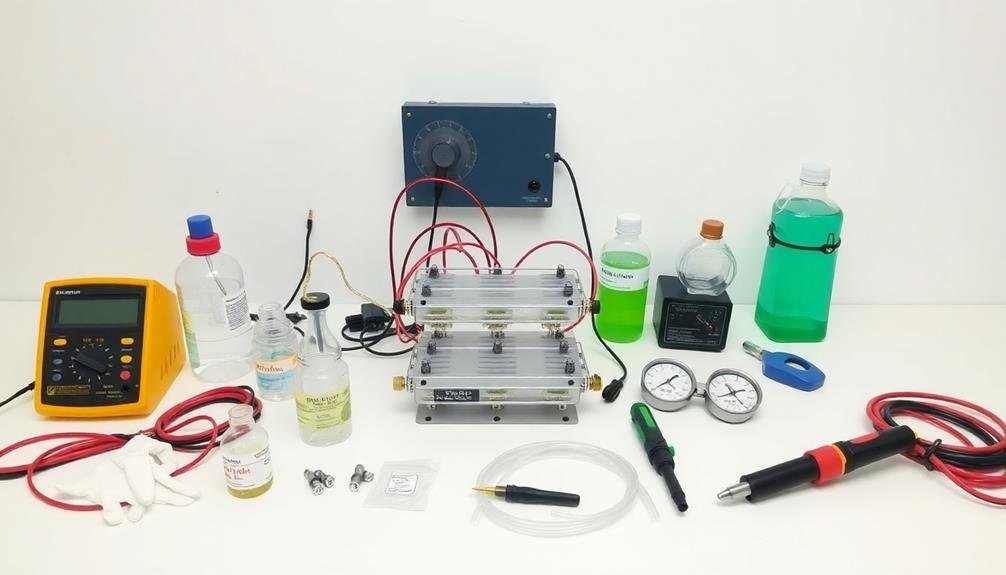
Before diving into the construction of your DIY hydrogen fuel cell, you'll need to gather several essential materials and tools. For the fuel cell itself, you'll require proton exchange membranes, catalysts (typically platinum-based), gas diffusion layers, and bipolar plates.
Don't forget to obtain a power source for electrolysis, such as solar panels or a wind turbine. You'll also need containers for storing hydrogen and oxygen, along with tubing and fittings for gas transport.
Safety equipment is vital, including a hydrogen leak detector, fire extinguisher, and personal protective gear like safety goggles and gloves.
For assembly, gather basic tools like screwdrivers, pliers, wire cutters, and a multimeter. A soldering iron and solder will be necessary for electrical connections. You may also need specialized tools like a hydraulic press for compressing fuel cell components.
To monitor your fuel cell's performance, invest in pressure gauges, flow meters, and a data acquisition system.
Designing Your Fuel Cell System
Designing an effective hydrogen fuel cell system requires careful planning and consideration of several key factors. You'll need to determine the power output required for your specific application, whether it's for a small electronics project or a larger home energy system. This will inform the size and number of fuel cells you'll need to incorporate.
Next, consider the fuel source and storage. You'll have to decide between using compressed hydrogen gas or generating hydrogen on-demand through electrolysis. Each method has its pros and cons regarding safety, efficiency, and complexity.
Don't forget to factor in proper ventilation and safety measures for hydrogen handling. Your design should also include a power management system to regulate the electrical output and protect the fuel cells from overloading.
You'll want to incorporate a battery bank for energy storage and to smooth out power delivery. Consider the overall system layout, ensuring easy access for maintenance and refueling.
Electrolysis Setup for Hydrogen Production
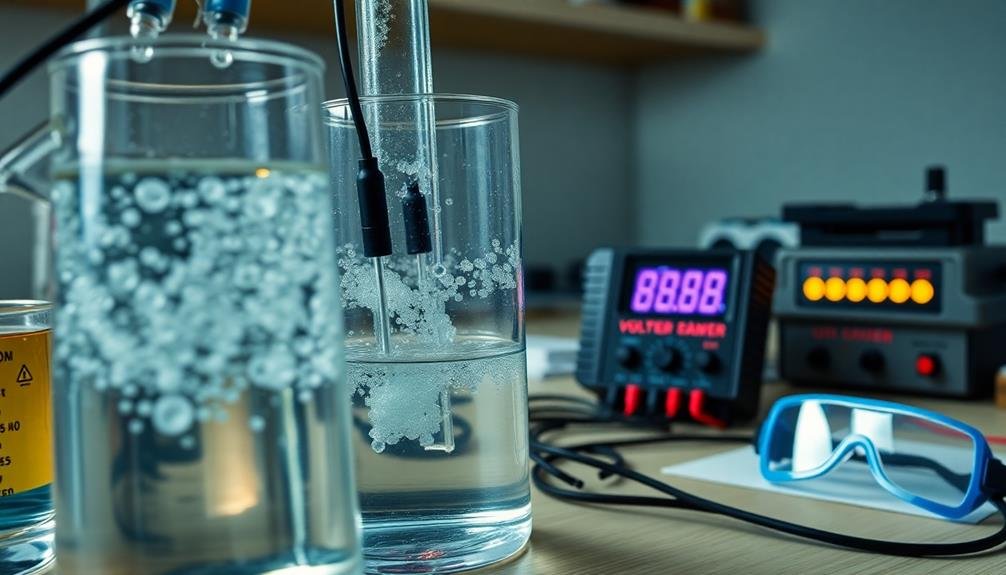
Now that you've designed your fuel cell system, let's focus on generating hydrogen through electrolysis. You'll need a power source, electrodes, and an electrolyte solution to split water into hydrogen and oxygen. Choose a reliable DC power supply, ensuring it can provide sufficient voltage and current for your setup.
Select durable electrodes, such as stainless steel or platinum-coated titanium, to withstand the electrolysis process. Prepare an electrolyte solution using distilled water and potassium hydroxide (KOH) or sodium hydroxide (NaOH). Be cautious when handling these chemicals, as they're corrosive.
Construct your electrolysis cell using a non-conductive container. Position the electrodes parallel to each other, maintaining a consistent distance. Connect the negative terminal to the cathode and the positive to the anode. Install a gas collection system to capture the produced hydrogen safely.
Implement safety measures, including proper ventilation and a hydrogen sensor. Monitor the electrolysis process closely, adjusting the power input as needed. Remember to purify the hydrogen before use in your fuel cell, removing any oxygen or moisture that could damage the system.
Assembling the Fuel Cell Stack
The fuel cell stack is the heart of your DIY hydrogen fuel cell system. It's where the electrochemical reaction occurs, converting hydrogen and oxygen into electricity and water. To assemble your stack, you'll need several key components: membrane electrode assemblies (MEAs), bipolar plates, and end plates.
Start by stacking the MEAs and bipolar plates alternately. Each MEA consists of a proton exchange membrane sandwiched between catalyst layers and gas diffusion layers. The bipolar plates, typically made of graphite or metal, separate the cells and distribute gases evenly.
Ensure proper alignment of all components as you stack them. Use gaskets between layers to prevent gas leaks. Once you've assembled the desired number of cells, place end plates on both sides of the stack. These provide structural support and contain gas inlets and outlets.
Compress the stack using tie rods or bolts, applying even pressure to maintain good electrical contact between components. Be careful not to over-tighten, as this can damage the delicate MEAs.
Integrating With Home Electrical Systems
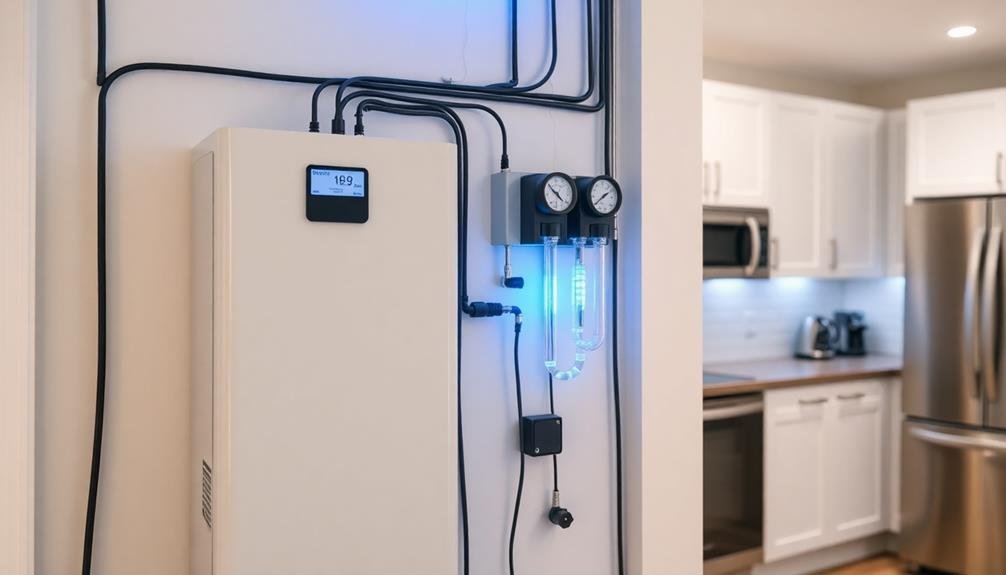
After assembling your fuel cell stack, you'll need to integrate it with your home's electrical system. This process requires careful planning and adherence to safety regulations. First, determine your power requirements and verify your fuel cell can meet them. You'll need an inverter to convert the DC output from the fuel cell to AC power for your home.
Install a transfer switch to safely connect your fuel cell to your home's electrical panel. This prevents backfeeding into the grid when your system is operating. You'll also need to set up a hydrogen storage system and verify proper ventilation for safety.
Here's a quick reference guide for integrating your fuel cell:
| Component | Function | Safety Consideration | Installation Complexity | Maintenance Frequency |
|---|---|---|---|---|
| Inverter | DC to AC conversion | Proper grounding | Moderate | Annual |
| Transfer Switch | Grid isolation | Correct wiring | High | Biennial |
| H2 Storage | Fuel supply | Leak detection | High | Quarterly |
| Ventilation | Gas dispersion | Adequate airflow | Moderate | Monthly |
| Monitoring System | Performance tracking | Alarm functionality | Low | Semi-annual |
Remember to consult with a licensed electrician and obtain necessary permits before attempting this integration. Regular maintenance and safety checks are vital for the longevity and safe operation of your home fuel cell system.
Storage and Compression Methods
When building your DIY hydrogen fuel cell system, you'll need to evaluate storage and compression methods.
Two primary options for storing hydrogen are pressure tanks or cylinders, which contain compressed hydrogen gas at high pressures.
Alternatively, you can explore metal hydride storage systems, which absorb hydrogen into specially designed alloys, allowing for safer storage at lower pressures.
Pressure Tanks and Cylinders
Designing an efficient hydrogen storage system, you'll need to contemplate pressure tanks and cylinders as fundamental components. These vessels are vital for safely containing compressed hydrogen gas at high pressures, typically ranging from 350 to 700 bar (5,000 to 10,000 psi).
When selecting pressure tanks, consider materials like carbon fiber-reinforced polymers or aluminum-lined composite cylinders. These offer excellent strength-to-weight ratios and corrosion resistance. Verify your tanks meet safety standards and are certified for hydrogen storage.
You'll need to factor in the tank's volume, which directly impacts the amount of hydrogen you can store. Larger tanks provide more capacity but require more space. Calculate your hydrogen consumption needs to determine the appropriate tank size.
Don't forget about safety features like pressure relief valves, temperature sensors, and leak detection systems. These are critical for preventing accidents and guaranteeing safe operation.
Proper installation is key. Mount tanks securely in well-ventilated areas, away from heat sources and potential ignition points.
Regular inspections and maintenance are essential to detect any wear or damage that could compromise safety.
Metal Hydride Storage Systems
Metal hydride storage systems offer an intriguing alternative to conventional high-pressure tanks for hydrogen storage.
These systems use special metal alloys that can absorb hydrogen atoms within their crystal structure, allowing for safe storage at low pressures. You'll find that metal hydrides can store hydrogen at densities higher than liquid hydrogen, making them a compact solution for your DIY fuel cell project.
To use a metal hydride system, you'll need to pressurize hydrogen gas slightly to initiate absorption. As the metal absorbs hydrogen, it releases heat. When you're ready to use the stored hydrogen, you'll apply heat to the metal hydride, causing it to release the gas. This process is reversible, allowing you to recharge the storage system multiple times.
While metal hydride systems offer safety advantages and high storage density, they're typically heavier than pressure tanks.
You'll also need to take into account the specific operating temperatures and pressures required for your chosen metal hydride alloy. Despite these challenges, metal hydride storage systems can be an excellent choice for small-scale hydrogen storage in your home fuel cell setup.
Maintenance and Troubleshooting

Keeping your DIY hydrogen fuel cell running smoothly calls for regular maintenance and quick troubleshooting skills. To guarantee peak performance, you'll need to monitor key components and address issues promptly. Start by inspecting the fuel cell stack, electrodes, and membrane for signs of wear or damage. Clean these parts gently with distilled water to remove any buildup.
Check your hydrogen storage system regularly for leaks and maintain proper pressure levels. Don't forget to examine electrical connections and replace any corroded wires. Here's a quick reference guide for common issues:
| Problem | Possible Cause | Solution |
|---|---|---|
| Low power output | Membrane degradation | Replace membrane |
| Excessive heat | Poor cooling | Clean or replace fan |
| Hydrogen leak | Loose connections | Tighten fittings |
| No power | Faulty wiring | Check and repair connections |
If you encounter persistent problems, consult your fuel cell's manual or seek expert advice. Remember, safety should always be your top priority when working with hydrogen systems. By staying vigilant and addressing issues early, you'll keep your DIY hydrogen fuel cell running efficiently for years to come.
Optimizing Efficiency and Output
To boost your DIY hydrogen fuel cell's performance, focus on two key areas: membrane material selection and electrode catalyst optimization.
You'll want to choose a membrane with high proton conductivity and low gas permeability, such as Nafion or similar perfluorinated polymers.
For the electrodes, you can improve catalytic activity by using finely dispersed platinum or platinum alloys on carbon supports, which will enhance reaction rates and overall efficiency.
Membrane Material Selection
The heart of your DIY hydrogen fuel cell lies in its membrane. Choosing the right material is essential for ideal performance and efficiency. Nafion is the industry standard, known for its excellent proton conductivity and chemical stability. However, it's expensive and sensitive to dehydration.
For a cost-effective alternative, consider sulfonated polyether ether ketone (SPEEK). It offers good proton conductivity and is more affordable.
If you're aiming for higher operating temperatures, phosphoric acid-doped polybenzimidazole (PBI) membranes are an excellent choice. They can withstand temperatures up to 200°C, improving your fuel cell's CO tolerance and overall efficiency.
For a more environmentally friendly option, look into chitosan-based membranes. They're derived from natural sources and offer decent performance.
When selecting your membrane, consider factors like thickness, ion exchange capacity, and mechanical strength. Thinner membranes generally provide better performance but may be less durable.
Higher ion exchange capacity improves proton conductivity but can lead to excessive swelling. Balance these properties based on your specific needs.
Electrode Catalyst Optimization
With your membrane selected, it's time to focus on enhancing the electrode catalysts for your DIY hydrogen fuel cell. The catalyst plays a vital role in accelerating the electrochemical reactions, enhancing efficiency and power output.
For the anode, platinum is the gold standard, but it's expensive. You can use platinum-ruthenium alloys or nickel-based catalysts as cost-effective alternatives. On the cathode side, platinum or platinum-cobalt alloys work well. Consider using carbon-supported catalysts to increase the surface area and reduce costs.
To improve your catalyst, focus on:
- Particle size: Smaller particles increase surface area and activity.
- Catalyst loading: Find the sweet spot between performance and cost.
- Catalyst distribution: Guarantee even coverage on the electrode surface.
Here's a quick comparison of common catalyst options:
| Catalyst | Advantages | Disadvantages |
|---|---|---|
| Platinum | High activity | Expensive |
| Pt-Ru alloy | CO-tolerant | Less active than Pt |
| Nickel-based | Low cost | Lower activity |
Experiment with different catalysts and loadings to find the best balance between performance and cost for your DIY fuel cell project.
Legal and Regulatory Compliance
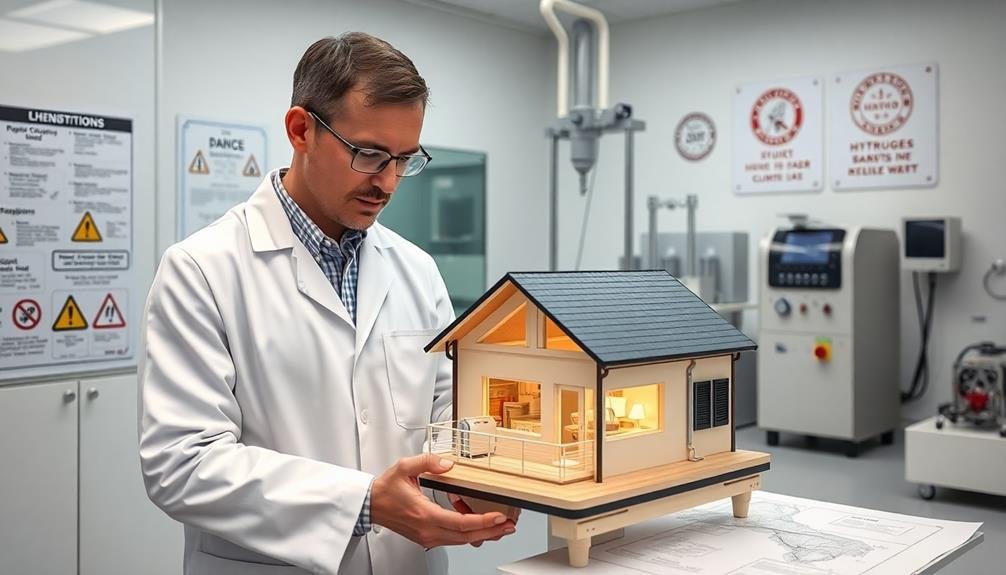
Before diving into your DIY hydrogen fuel cell project, it's vital to understand and comply with relevant laws and regulations. Start by researching your local building codes and zoning laws, as some areas may restrict or prohibit hydrogen fuel cell installations in residential settings.
You'll need to obtain proper permits and inspections to guarantee your system meets safety standards.
Check with your local fire department for specific requirements regarding hydrogen storage and use. Many jurisdictions have strict guidelines on the amount of hydrogen you can store and how it must be contained.
You'll also need to comply with electrical codes when connecting your fuel cell to your home's power system.
Be aware of any environmental regulations that may apply to your project, particularly regarding emissions and waste disposal. If you plan to sell excess power back to the grid, familiarize yourself with your state's net metering laws and utility company requirements.
Consider consulting with a legal professional or regulatory expert to confirm you're fully compliant.
Joining local renewable energy groups can provide valuable insights into traversing the regulatory landscape.
Frequently Asked Questions
Can Hydrogen Fuel Cells Power Vehicles as Well as Homes?
Yes, hydrogen fuel cells can power both vehicles and homes. You'll find them in cars, buses, and even some trains. They're versatile, offering clean energy for transportation and stationary applications like residential power systems.
How Does the Cost of Hydrogen Fuel Compare to Traditional Electricity?
You'll find hydrogen fuel is generally more expensive than traditional electricity. It's costlier to produce and distribute. However, as technology improves and production scales up, you might see prices become more competitive in the future.
Are There Any Government Incentives for Installing Home Hydrogen Fuel Cells?
You'll find some government incentives for home hydrogen fuel cells, but they vary by location. Check your state and local programs for potential tax credits, rebates, or grants. Don't forget to explore federal incentives too.
What Happens to Excess Hydrogen Produced by the System?
You'll need to store excess hydrogen safely in tanks or cylinders. You can use it later, sell it to others, or power other devices. Be sure you're following all safety regulations for hydrogen storage and handling.
Can Hydrogen Fuel Cells Be Used as a Backup During Power Outages?
Yes, you can use hydrogen fuel cells as backup power during outages. They'll provide reliable electricity as long as you have hydrogen fuel. They're quiet, clean, and can run continuously, unlike generators that need refueling.
In Summary
You've now got the knowledge to build your own hydrogen fuel cell system for home power. Remember to prioritize safety, follow regulations, and optimize your setup for efficiency. While it's a complex project, the rewards of clean, sustainable energy are worth the effort. Keep learning, experimenting, and refining your system. You're not just powering your home—you're contributing to a greener future. Stay safe and enjoy your DIY energy journey!

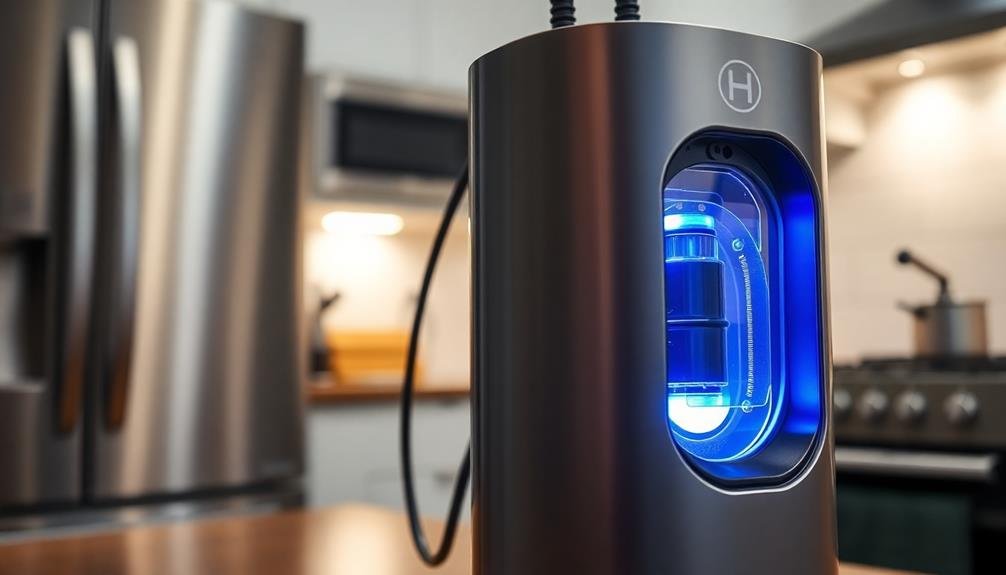



Leave a Reply